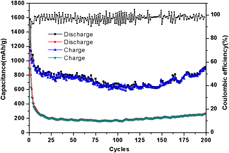Crossref Citations
This article has been cited by the following publications. This list is generated based on data provided by
Crossref.
Wang, Meng-Han
and
Guo, Sheng-Ping
2020.
Highly uniform hollow CuCo2S4@C dodecahedra derived from ZIF–67 for high performance lithium–ion batteries.
Journal of Alloys and Compounds,
Vol. 832,
Issue. ,
p.
154978.
Pant, Bishweshwar
Pant, Hem Raj
and
Park, Mira
2020.
Fe1−xS Modified TiO2 NPs Embedded Carbon Nanofiber Composite via Electrospinning: A Potential Electrode Material for Supercapacitors.
Molecules,
Vol. 25,
Issue. 5,
p.
1075.
Chen, Yun
Liu, Hongbin
Guo, Xiaolin
Zhu, Shangping
Zhao, Yue
Iikubo, Satoshi
and
Ma, Tingli
2021.
Bimetallic Sulfide SnS2/FeS2 Nanosheets as High-Performance Anode Materials for Sodium-Ion Batteries.
ACS Applied Materials & Interfaces,
Vol. 13,
Issue. 33,
p.
39248.
Zhou, Jian-En
Chen, Jiahao
Peng, Yanhua
Zheng, Yongqian
Zeb, Akif
and
Lin, Xiaoming
2022.
Metal-organic framework-derived transition metal sulfides and their composites for alkali-ion batteries: A review.
Coordination Chemistry Reviews,
Vol. 472,
Issue. ,
p.
214781.
Zhan, Guanghao
Yan, Ruibo
Liao, Wenhua
Hu, Qianqian
and
Huang, Xiaoying
2023.
A facile precursor route towards the synthesis of Fe1−xS@NC-rGO composite anode materials for high-performance lithium-ion batteries.
Dalton Transactions,
Vol. 52,
Issue. 6,
p.
1711.
Yuan, Shaohui
Li, Jiexiang
Xia, Wei
Li, Zhaopeng
Tian, Wenyue
Yang, Yue
Ji, Xiaobo
and
Ge, Peng
2024.
Regenerated Natural Minerals towards Double‐layers Heterojunctions Metal@metal‐sulfides with Remarkable Conductivity for Ultra‐fast Sodium‐ion Storage.
Advanced Functional Materials,
Vol. 34,
Issue. 49,
Huang, Na
Zhang, Hehe
Zhu, Guanjia
Tang, Cheng
Cheng, Zhongling
Du, Aijun
Wang, Ming-Sheng
and
Zhang, Haijiao
2024.
Yolk-shell structured FeS0.5Se0.5@N-doped mesoporous carbon composite as high-performance lithium-ion battery anodes.
Chemical Engineering Journal,
Vol. 502,
Issue. ,
p.
157959.
Haruna, Baffa
Wang, Lina
Hu, Xiang
Luo, Guangfu
Muhammad, Mujtaba Aminu
Liu, Yangjie
Yu, Jiaqi
Abdel‐Aziz, Ahmed
Bao, Hongli
and
Wen, Zhenhai
2025.
Se‐Rich Functionalized FeSx Hollow Nanospheres for Accelerated and Long‐Lasting Sodium Storage.
Advanced Functional Materials,
Vol. 35,
Issue. 4,
